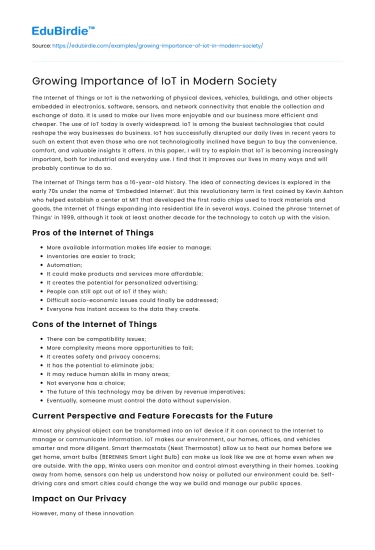The Internet of Things or IoT is the networking of physical devices, vehicles, buildings, and other objects embedded in electronics, software, sensors, and network connectivity that enable the collection and exchange of data. It is used to make our lives more enjoyable and our business more efficient and cheaper. The use of IoT today is overly widespread. IoT is among the busiest technologies that could reshape the way businesses do business. IoT has successfully disrupted our daily lives in recent years to such an extent that even those who are not technologically inclined have begun to buy the convenience, comfort, and valuable insights it offers. In this paper, I will try to explain that IoT is becoming increasingly important, both for industrial and everyday use. I find that it improves our lives in many ways and will probably continue to do so.
The Internet of Things term has a 16-year-old history. The idea of connecting devices is explored in the early 70s under the name of ‘Embedded Internet’. But this revolutionary term is first coined by Kevin Ashton who helped establish a center at MIT that developed the first radio chips used to track materials and goods, the Internet of Things expanding into residential life in several ways. Coined the phrase ‘Internet of Things’ in 1999, although it took at least another decade for the technology to catch up with the vision.
Save your time!
We can take care of your essay
- Proper editing and formatting
- Free revision, title page, and bibliography
- Flexible prices and money-back guarantee
Pros of the Internet of Things
- More available information makes life easier to manage;
- Inventories are easier to track;
- Automation;
- It could make products and services more affordable;
- It creates the potential for personalized advertising;
- People can still opt out of IoT if they wish;
- Difficult socio-economic issues could finally be addressed;
- Everyone has instant access to the data they create.
Cons of the Internet of Things
- There can be compatibility issues;
- More complexity means more opportunities to fail;
- It creates safety and privacy concerns;
- It has the potential to eliminate jobs;
- It may reduce human skills in many areas;
- Not everyone has a choice;
- The future of this technology may be driven by revenue imperatives;
- Eventually, someone must control the data without supervision.
Current Perspective and Feature Forecasts for the Future
Almost any physical object can be transformed into an IoT device if it can connect to the Internet to manage or communicate information. IoT makes our environment, our homes, offices, and vehicles smarter and more diligent. Smart thermostats (Nest Thermostat) allow us to heat our homes before we get home, smart bulbs (BERENNIS Smart Light Bulb) can make us look like we are at home even when we are outside. With the app, Winka users can monitor and control almost everything in their homes. Looking away from home, sensors can help us understand how noisy or polluted our environment could be. Self-driving cars and smart cities could change the way we build and manage our public spaces.
Impact on Our Privacy
However, many of these innovations could have major implications for our privacy. It becomes obvious that both people and companies are attracted to the world of IoT, without thinking much about what it can do to their privacy and security.
Manufacturers ignore privacy and security concerns because of business opportunities, and most consumers do not take this into account. Companies neglect privacy and security of course because all the data they collect is most likely another source of revenue.
The U.S. House of Representatives passed the Internet Safety Improvement Act of 2020 was signed by law on December 4, resulting in the first federal Internet of Things (IoT) regulation. Addressing concerns about privacy and security, the goal of the law is to establish minimum security standards for Internet of Things devices owned or controlled by the Federal Government and for other purposes.
The law is a significant success for the IoT industry, but it is just the beginning. As the world becomes more integrated through connected devices, the need for global standards remains in focus.






 Stuck on your essay?
Stuck on your essay?

